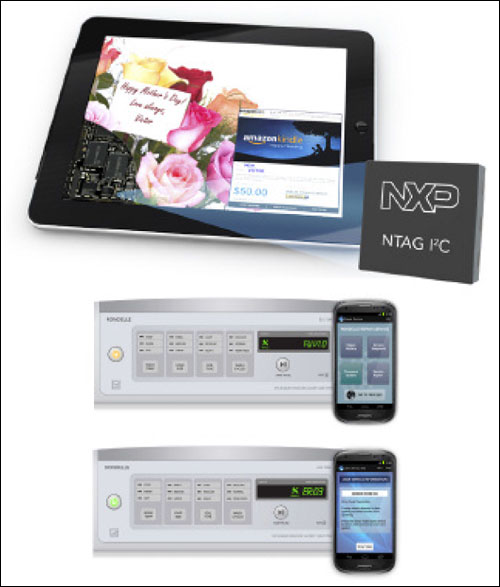If only the walls—and other things—could talk! Now they can—and you can talk to them—thanks to NXP Semiconductors‘ new NTAG I²C NFC chip, which adds smart functionality to household appliances, thermostats, automobiles, office equipment, health-care devices and building infrastructure.
The chip combines passive high-frequency Near-Field Communication technology with a built-in I²C interface, enabling users to communicate directly with any tagged item via an NFC reader. What’s smart about this solution is that it does not require consumers or businesses to purchase dedicated RFID readers. Instead, you can use the NFC reader that’s standard on most mobile phones today to connect with the tagged products or things.

“Thirty years or so ago, when we were Philips Semiconductors, we invented the I²C serial interface,” says Victor Vega, NXP’s director of NFC and RFID solutions. “For our NTAG I²C chip, what we did was add a front-end NFC RFID, and connect it with I²C on the back end, so you dynamically make changes to a device whether there is power on or not.”
An appliance manufacturer, for example, could install an NTAG I²C chip inside a basic washing machine and transform that appliance into a high-end product with more features, for little additional cost, Vega says.
“Washing machines come in two flavors,” he says. “One might be the low end of the spectrum, where you have your basic settings, such as temperature. But we can use an NFC phone as a remote interface and get a lot more.”
For businesses, the NTAG I²C chip could solve the problem of getting consumers to register new appliances with manufacturers, Vega says. Tapping a smartphone against a washing machine when it is turned on for the first time enables the phone’s NFC reader to receive the machine’s serial and model numbers. “My phone has my personal information,” Vega explains, “so for my registration process, I can say ‘autofill and submit.’ I am now registered in the cloud. Only 35 percent of the population fills out the warranty card, and when they do it costs the product manufacturer $2 apiece. So we just saved the company big bucks and got the population to register.”
Consumers could access a range of options when they’re ready to do a load of wash. Most basic machines offer limited settings: cold, warm, hot; small, medium, large. But when a consumer taps a smartphone against a washing machine, the handset’s screen could display an expanded range of choices. “Instead of 140 degrees, maybe I want 115,” Vega says. “Maybe I want something in between small and medium for my load size. I can pick soil type and extend my spin cycle. If my child is napping, I can turn off the machine’s alert function. And I can put the child-protection feature on, so he can’t put the cat in the machine and turn it on.”
If the washing machine LED screen displays an error code, instead of hunting for the owner’s manual, the user could tap the phone against the machine and the phone would retrieve the information from the Internet, Vega says. “Error 3, the phone tells the consumer, indicates we have a foreign object in the gasket,” he says. “Then, the phone provides an instructional video. Now, I eliminated the need for a service call.”
If an appliance is completely out of commission and requires a service call, a consumer could tap the phone against the machine to schedule an appointment via the Internet, Vega says. When the repair worker arrives, he or she could tap a smartphone against the appliance to put the machine in service-diagnostics mode and retrieve all the error codes stored in the NTAG I²C tag, as well as the machine’s repair history. If the problem were related to the appliance’s firmware, Vega says, the worker could have the phone retrieve new firmware via the Internet and use the handset’s NFC reader to load that software into the machine.
The appliance manufacturer could provide all this additional functionality merely by installing an NTAG I²C chip, at a cost of less than 50 cents, Vega says. To build comparable features into the appliance, he notes, might require a $20 touch screen and $10 Wi-Fi unit.
The NTAG I²C chip also could be used for other applications. The chip’s RF energy-harvesting feature, for instance, could power LEDs and sensors via an NFC phone. In California, for example, buildings could have stress indicators installed on the supporting beams behind walls to detect damage caused by earthquakes, Vega says. “You don’t want to open up the Sheetrock, and you don’t want to put batteries in there,” he says. “So what do you do?”
His suggestion: Install passive strain gauges powered by an NTAG I²C chip. Once a year, an employee could visit the building and tap an NFC phone against the walls; the sensors would indicate whether the beams were intact.
There is a multitude of other ways the NTAG I²C chip could help end users solve business problems or improve business operations, Vega says. A worker at a car-rental company, for example, could use a smartphone to quickly retrieve mileage, fuel, fluid levels and other information. “Your mind can go nuts with what you can do with this chip,” he says.

